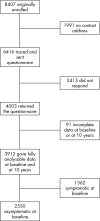Initial poor quality of life and new onset of dyspepsia: results from a longitudinal 10-year follow-up study
- PMID: 16908511
- PMCID: PMC1856829
- DOI: 10.1136/gut.2006.099846
Initial poor quality of life and new onset of dyspepsia: results from a longitudinal 10-year follow-up study
Abstract
Background: Numerous studies examining the prevalence and natural history of dyspepsia in the general population have been conducted. However, few have reported the effect of quality of life on the development of dyspepsia. A 10-year longitudinal follow-up study examining the effect of quality of life on subsequent dyspepsia was performed.
Methods: Individuals originally enrolled in a population-screening programme for Helicobacter pylori were contacted through a validated postal dyspepsia questionnaire. Baseline demographic data, quality of life at original study entry, and dyspepsia and irritable bowel syndrome (IBS) symptom data were already on file. Consent to examine primary-care records was sought, and data regarding non-steroidal anti-inflammatory drugs (NSAID) and aspirin use were obtained from these.
Results: Of 8407 individuals originally involved, 3912 (46.5%) provided symptom data at baseline and 10-year follow-up. Of 2550 (65%) individuals asymptomatic at study entry, 717 (28%) developed new-onset dyspepsia at 10 years, an incidence of 2.8% per year. After multivariate logistic regression, lower quality of life at study entry (OR 2.63; 99% CI 1.86 to 3.71), higher body mass index (OR per unit 1.05; 99% CI 1.02 to 1.08), presence of IBS at study entry (OR 3.1; 99% CI 1.51 to 6.37) and use of NSAIDs and/or aspirin (OR 1.32; 99% CI 0.99 to 1.75) were significant risk factors for new-onset dyspepsia.
Conclusions: The incidence of new-onset dyspepsia was almost 3% per year. Low quality of life at baseline exerted a strong effect on the likelihood of developing dyspepsia at 10 years.
Conflict of interest statement
Competing interests: declared (the declaration can be viewed on the
References
-
- Penston J G, Pounder R E. A survey of dyspepsia in Great Britain. Aliment Pharmacol Ther 19961083–89. - PubMed
MeSH terms
Substances
LinkOut - more resources
Full Text Sources
Medical
Molecular Biology Databases

